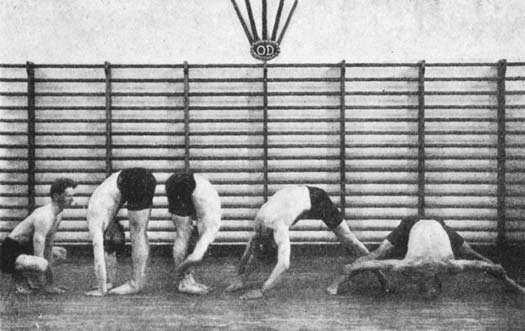Yoga As We Know It
I knew it, I knew it! I have long been suspicious of the claims that my yoga teachers have made about the great antiquity of the postures that they were teaching us. Okay, so there were sculptures of yogis and Buddhas sitting in Lotus, but where were all the Downward Dogs and Warriors, Headstands and Forward Bends? Why couldn't any of the books show us illustrations or even properly referenced descriptions of these poses in the ancient sources if there were any? Well, as historian Mark Singleton has recently reported in Yoga Journal (November 2010), it's because there aren't.*
It gets better (or worse, depending on how important you think antiquity is). Not only aren't these poses--and more or less all of the others which aspiring yogis and yoginis practice so diligently in yoga studios and health clubs the (Westernized) world over--particularly ancient. They aren't even Indian. They are, you guessed it, Western to begin with. To be exact, 19th-century Scandinavian. Everything--the five-count format, the abdominal "locks", the jump-through and the postures--appears in an early 20th-century Danish system called Primitive Gymnastics which was itself a derivative of a 19th-century Scandinavian model that, as Singleton explains, "sprang up throughout Europe and became the basis for physical training in armies, navies, and many schools. These systems also found their way to India. In the 1920s, according to a survey taken by the Indian YMCA, Primitive Gymnastics was one of the most popular forms of exercise in the whole subcontinent, second only to the original Swedish gymnastics developed by P.H. Ling."
And guess who decided that it would be a good thing to teach this form of exercise as yoga? Right: modern yoga founding fathers Kuvalayananda (1883-1966) and T. Krishnamacharya (1888-1989), the latter the teacher of such global yoga luminaries as B.K.S. Iyengar, K. Pattabhi Jois, Indra Devi and T.K.V. Desikachar. I love it. Here we've been, for the past, oh, twenty or thirty or sixty years worrying about the effects of bringing yoga to the West, corrupting its spiritual tradition by teaching it in health clubs as "merely" gymnastics--and all along, that's what it was, exercise. To be sure, Krishnamacharya blended his gymnastics with philosophical teachings from orthodox Hinduism and Ayurveda. But the postures we Westerners have been flocking to India to learn for the past two or three generations were arguably so appealing to those from our culture because they already were ours, just dressed up in fancy new names. Yes, these postures were appealing to the Indians, too, thus all those classes in the 1920s at the YMCA. But how many Westerners would have been so eager to spend their lives doing Downward Dog or Fish pose without the assurance that these postures came with a venerable history going back 3,000 or 10,000 or (I don't know) 100,000 years?
 Singleton confesses to having experienced something like a crisis of faith at this point in his research: how could he continue teaching his own students these postures if they did not in fact have their roots in the ancient tradition of Patanjali, the Upanishads and the Vedas? He concludes that it doesn't really matter. They don't need to be ancient to be "authentic," they are simply a modern graft onto the great tree of yoga. But I wonder. Would he have come to the same conclusion if he had found, as I just did on a search in Google books**, that Niels Bukh, the founder of "Primitive Gymnastics," was particularly inspired by his contemporary athletics promoter, Adolf Hitler, and that he expressly intended his "serial gymnastics" (shades of Ashtanga) for men?***
Singleton confesses to having experienced something like a crisis of faith at this point in his research: how could he continue teaching his own students these postures if they did not in fact have their roots in the ancient tradition of Patanjali, the Upanishads and the Vedas? He concludes that it doesn't really matter. They don't need to be ancient to be "authentic," they are simply a modern graft onto the great tree of yoga. But I wonder. Would he have come to the same conclusion if he had found, as I just did on a search in Google books**, that Niels Bukh, the founder of "Primitive Gymnastics," was particularly inspired by his contemporary athletics promoter, Adolf Hitler, and that he expressly intended his "serial gymnastics" (shades of Ashtanga) for men?***
*Yoga Body: The Origins of Modern Posture Practice (Oxford, 2010).
**For Singleton's book, but also for images that I might use to illustrate this post.
***Hans Bonde, "The Iconic Symbolism of Niels Bukh: Aryan Body Culture, Danish Gymnastics," in Shaping the Superman: Fascist Body as Political Icon, ed. J.A. Mangan (London, 2000), vol. 2, pp. 104-118.****
****[Update: In answer to my rhetorical question, yes, he would. In his book, Singleton shows in detail how the fusion of yoga with athletic and body-building physical culture was closely bound up with late nineteenth- and early twentieth-century ideals of "manliness." He likewise, however, points to a different, contemporary culture of breathing and stretching developed by women in the West which would seem to underpin the yoga practice of many Western women today. Either way, yoga as we know it has deep roots in the West.]
[UPDATE: Watch MILO on how yoga as we practice it in the West is not cultural appropriation—it is Primitive Gymnastics!]
It gets better (or worse, depending on how important you think antiquity is). Not only aren't these poses--and more or less all of the others which aspiring yogis and yoginis practice so diligently in yoga studios and health clubs the (Westernized) world over--particularly ancient. They aren't even Indian. They are, you guessed it, Western to begin with. To be exact, 19th-century Scandinavian. Everything--the five-count format, the abdominal "locks", the jump-through and the postures--appears in an early 20th-century Danish system called Primitive Gymnastics which was itself a derivative of a 19th-century Scandinavian model that, as Singleton explains, "sprang up throughout Europe and became the basis for physical training in armies, navies, and many schools. These systems also found their way to India. In the 1920s, according to a survey taken by the Indian YMCA, Primitive Gymnastics was one of the most popular forms of exercise in the whole subcontinent, second only to the original Swedish gymnastics developed by P.H. Ling."
And guess who decided that it would be a good thing to teach this form of exercise as yoga? Right: modern yoga founding fathers Kuvalayananda (1883-1966) and T. Krishnamacharya (1888-1989), the latter the teacher of such global yoga luminaries as B.K.S. Iyengar, K. Pattabhi Jois, Indra Devi and T.K.V. Desikachar. I love it. Here we've been, for the past, oh, twenty or thirty or sixty years worrying about the effects of bringing yoga to the West, corrupting its spiritual tradition by teaching it in health clubs as "merely" gymnastics--and all along, that's what it was, exercise. To be sure, Krishnamacharya blended his gymnastics with philosophical teachings from orthodox Hinduism and Ayurveda. But the postures we Westerners have been flocking to India to learn for the past two or three generations were arguably so appealing to those from our culture because they already were ours, just dressed up in fancy new names. Yes, these postures were appealing to the Indians, too, thus all those classes in the 1920s at the YMCA. But how many Westerners would have been so eager to spend their lives doing Downward Dog or Fish pose without the assurance that these postures came with a venerable history going back 3,000 or 10,000 or (I don't know) 100,000 years?
 Singleton confesses to having experienced something like a crisis of faith at this point in his research: how could he continue teaching his own students these postures if they did not in fact have their roots in the ancient tradition of Patanjali, the Upanishads and the Vedas? He concludes that it doesn't really matter. They don't need to be ancient to be "authentic," they are simply a modern graft onto the great tree of yoga. But I wonder. Would he have come to the same conclusion if he had found, as I just did on a search in Google books**, that Niels Bukh, the founder of "Primitive Gymnastics," was particularly inspired by his contemporary athletics promoter, Adolf Hitler, and that he expressly intended his "serial gymnastics" (shades of Ashtanga) for men?***
Singleton confesses to having experienced something like a crisis of faith at this point in his research: how could he continue teaching his own students these postures if they did not in fact have their roots in the ancient tradition of Patanjali, the Upanishads and the Vedas? He concludes that it doesn't really matter. They don't need to be ancient to be "authentic," they are simply a modern graft onto the great tree of yoga. But I wonder. Would he have come to the same conclusion if he had found, as I just did on a search in Google books**, that Niels Bukh, the founder of "Primitive Gymnastics," was particularly inspired by his contemporary athletics promoter, Adolf Hitler, and that he expressly intended his "serial gymnastics" (shades of Ashtanga) for men?****Yoga Body: The Origins of Modern Posture Practice (Oxford, 2010).
**For Singleton's book, but also for images that I might use to illustrate this post.
***Hans Bonde, "The Iconic Symbolism of Niels Bukh: Aryan Body Culture, Danish Gymnastics," in Shaping the Superman: Fascist Body as Political Icon, ed. J.A. Mangan (London, 2000), vol. 2, pp. 104-118.****
****[Update: In answer to my rhetorical question, yes, he would. In his book, Singleton shows in detail how the fusion of yoga with athletic and body-building physical culture was closely bound up with late nineteenth- and early twentieth-century ideals of "manliness." He likewise, however, points to a different, contemporary culture of breathing and stretching developed by women in the West which would seem to underpin the yoga practice of many Western women today. Either way, yoga as we know it has deep roots in the West.]
[UPDATE: Watch MILO on how yoga as we practice it in the West is not cultural appropriation—it is Primitive Gymnastics!]






I have suspected as much. Thanks for the insight. I have never met an Indian who thought "downward dog" was actual yoga.
ReplyDeleteVeeeeery interesting. And funny. So what do the "asanas" (postures) in Patanjali's yoga sutras refer to? And who came up with the wacky Sanskrit names for the poses? (And, for that matter, is it proper Sanskrit, or mangled?)
ReplyDeleteThis also makes it all the more funny that some fundamentalist Christians object to yoga being taught in school as physical education, on the grounds that it is inculcating kids in a religion....
Isn't it, though? I think asana simply means "posture good for meditation" in the older tradition (i.e. Lotus), but I've only read Singleton's piece in YJ and the introduction to his book thus far. I'll let you know what I find out about the names of the other postures. And, yes, I find it amusing that the fundamentalist fears aren't really applicable. Funny old world. Almost everything that we think of as having origins lost in the mists of time actually dates back around 150 years ago. Including modern understandings of Christianity.
ReplyDeleteThat is, fundamentalism.
ReplyDeleteThat is, fundamentalism is not "medieval," it's modern. Just like the postural yoga that every one wants to believe is so ancient.
ReplyDeletebut here is the question this poses, If it is "western", why did it die out in the west?!!! such a useful system should have survived shouldn't it. especially if it has managed to grow as "Yoga".
ReplyDeleteDo you mean the Swedish exercises? I seem to remember those still being popular when I was younger. But the best evidence for yoga's dependence on Western ideals of physical culture is surely its success since the 1960s.
ReplyDelete